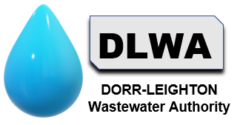The Dorr-Leighton Wastewater Authority is the designated sewage service provider for residents and businesses located in five (5) Service Districts established by the Dorr and Leighton Township Boards.
Service Districts
- Districts 1, and 2 serve the Village of Moline and the industrial customers north along Division Street.
- District 3 serves customers south of 144th Avenue and east of 14th Street.
- Districts 4 and 5 serve customers along both sides of 144th Avenue west of 14th Street to
the Murphy Drain at the west end of Dorr.
History
Dorr and Leighton Township Boards both formally established the Authority under Michigan Act 233 to act on all matters related to the operation, maintenance, replacement, and funding associated with wastewater collection and treatment in their respective Service Districts.
The cooperative partnership for wastewater management between Dorr and Leighton Townships in Allegan County began from a follow up odor complaint investigation initiated by State of Michigan Water Resources Commission staff in August 1971.
On September 24, 1971, a letter was sent by the Michigan Water Resources Commission Basin Engineer, Mr. Chester Harvey to Mr. Wayne Steeby, Leighton Township Supervisor, informing the Township of a complaint investigation concerning odors and the possibility of raw sewage in the Moline Drain, designated as “waters of the State”. The investigation survey report concluded that both the Moline and Bates Drains in Leighton and Dorr Townships respectively, contained raw sewage and improperly treated waste discharges from sewers and drains within the unincorporated Village of Moline, which lies within both Townships. Dorr and Leighton Townships were directed to “initiate and vigorously pursue a corrective program to eliminate the raw and improperly treated…discharges”.
About this same time, the Federal government initiated the Water Pollution Control Act to assist communities with planning, designing, constructing, and financing wastewater systems to improve the nation’s water quality. Grants (80%) with local financial participation (20%) were made available to communities agreeing to pursue the required Steps for the Federal and State monies. Leighton Township and Dorr Township were advised that this program might be a viable solution to their water pollution issues in the Village of Moline. Leighton officials opted to apply for grant monies and agreed to conduct the study/planning/design for a wastewater system to serve the Village of Moline and the Green Lake area in the Township. Dorr Township partnered in this effort for their portion of the Village of Moline and agreed to participate financially if Leighton officials would take the lead in the application processes.
- In August 1972, both Townships began taking the steps required for securing financing to construct a joint wastewater collection and treatment system and a year later received funding to proceed.
- In September 1977, the construction project received approval from the Michigan Department of Natural Resources Environmental Bureau and the work was initiated.
All of the hard work to bring the Dorr-Leighton Wastewater System to this point also presented the realization that a long term financing, administration, and management strategy was needed to conduct the day to day functions of the System. The Dorr-Leighton Waste Water Authority (DLWA) was established under provisions within Act 233, Public Acts of Michigan, 1955, as amended after unanimous adoption of the required Articles of Incorporation by both Township Boards in April 1978.
Today the DLWA continues to function and serve not only the initial 240 customers in the Village of Moline, but also other commercial, business, and residential customers approaching the equivalent of 1400 single family homes located in the five (5) Service Districts.
Plant History
The Dorr-Leighton Wastewater Treatment Plant was constructed in 1978 to serve approximately 240 homes in the Village of Moline. The flow into the new facility was approximately 55,000 gallons per day, a little over 50% of design (100,000 gallons per day) until the early 1990’s. The facility discharged approximately 16 million gallons from its two (2) wastewater stabilization ponds into Green Lake Creek annually, again approximately 50% of design (37 million gallons). Area growth pressure threatened an expansion as a large mobile home development and industrial park were considered by the Townships. These two (2) projects alone, without any further area growth, consumed the remaining system capacity and a decision to expand was imminent. Both Townships continued to monitor the situation and began to seek funding and
design services for an expanded facility.
The first DLWA system expansion was constructed in 1999. The new facility employed a higher level of treatment using aeration and naturally occurring microorganisms. The process called “sequencing batch reactors (SBR’s) was installed along with chemical phosphorus removal and biosolids storage for the generated solids from treating the wastewater. The new facility was
designed for an average of 250,000 gallons per day of flow. Area growth continued through 2015-16 and again, flows and growth seemed to point to the need for a second system expansion as daily flows approached 200,000 gallons per day and over 1300 single family home units (REU’s). Over the next three (3) years, the Authority secured financing from the US Department
of Agriculture for a low interest loan and design services were initiated and construction contracts were bid in early 2020.
In April 2020, the current facility expansion began in spite of Covid 19 pandemic. The project was deemed an “essential service” project and the contractor was willing to start/continue work. The project was completed in 2022 and will treat approximately 550,000 gallons.

